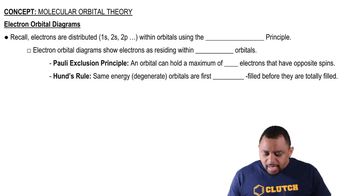The valence electron configurations of several atoms are shown here. How many bonds can each atom make without hybridization? c. Be 2s2
Ch.11 - Chemical Bonding II: Molecular Shapes, VSEPR & MO Theory
All textbooks Tro 6th Edition
Tro 6th Edition Ch.11 - Chemical Bonding II: Molecular Shapes, VSEPR & MO Theory
Ch.11 - Chemical Bonding II: Molecular Shapes, VSEPR & MO Theory Problem 57
Problem 57
 Tro 6th Edition
Tro 6th Edition Ch.11 - Chemical Bonding II: Molecular Shapes, VSEPR & MO Theory
Ch.11 - Chemical Bonding II: Molecular Shapes, VSEPR & MO Theory Problem 57
Problem 57Chapter 11, Problem 57
Write orbital diagrams (boxes with arrows in them) to represent the electron configuration of carbon before and after sp3 hybridization.
 Verified step by step guidance
Verified step by step guidance1
Start by writing the ground state electron configuration of carbon, which is 1s^2 2s^2 2p^2.
Draw the orbital diagram for the ground state configuration: two arrows in the 1s box, two arrows in the 2s box, and two arrows in the 2p boxes, with one arrow in each of the first two 2p boxes.
Understand that in sp3 hybridization, one electron from the 2s orbital is promoted to the empty 2p orbital, resulting in the configuration 1s^2 2s^1 2p^3.
Draw the orbital diagram for the hybridized state: two arrows in the 1s box, one arrow in the 2s box, and one arrow in each of the three 2p boxes.
Combine the 2s and 2p orbitals to form four equivalent sp3 hybrid orbitals, each containing one electron, ready to form covalent bonds.

Verified video answer for a similar problem:
This video solution was recommended by our tutors as helpful for the problem above.
Video duration:
1mWas this helpful?
Key Concepts
Here are the essential concepts you must grasp in order to answer the question correctly.
Electron Configuration
Electron configuration describes the distribution of electrons in an atom's orbitals. For carbon, which has six electrons, the ground state configuration is 1s² 2s² 2p². This notation indicates that two electrons occupy the 1s orbital, two occupy the 2s orbital, and two occupy the 2p orbitals, which is crucial for understanding how carbon bonds and hybridizes.
Recommended video:
Guided course

Electron Configuration Example
Orbital Diagrams
Orbital diagrams visually represent the arrangement of electrons in an atom's orbitals using boxes and arrows. Each box represents an orbital, and arrows indicate the presence of electrons, with their direction showing spin. These diagrams help illustrate the filling order of orbitals according to the Aufbau principle, Hund's rule, and the Pauli exclusion principle, which are essential for understanding electron configurations.
Recommended video:
Guided course

Electron Orbital Diagrams
sp3 Hybridization
sp3 hybridization occurs when one s orbital and three p orbitals mix to form four equivalent hybrid orbitals, which are oriented tetrahedrally. In carbon, this hybridization allows for the formation of four sigma bonds, as seen in molecules like methane (CH₄). Understanding sp3 hybridization is key to grasping how carbon can form stable covalent bonds with other atoms.
Recommended video:
Guided course

Hybridization
Related Practice
Textbook Question
Textbook Question
Write orbital diagrams (boxes with arrows in them) to represent the electron configurations—without hybridization—for all the atoms in SF2. Circle the electrons involved in bonding. Draw a three-dimensional sketch of the molecule and show orbital overlap. What bond angle do you expect from the unhybridized orbitals? How well does valence bond theory agree with the experimentally measured bond angle of 98.2° ?
6
views
Textbook Question
Write orbital diagrams (boxes with arrows in them) to represent the electron configurations of carbon before and after sp hybridization.
Textbook Question
Which hybridization scheme allows the formation of at least one p bond? sp3, sp2, sp3d2
Textbook Question
Which hybridization scheme allows the central atom to form more than four bonds? sp3, sp3d, sp2